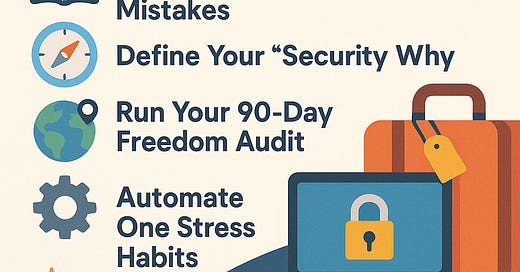Digital Resilience for Nomads: 5 Steps to Stay Free and Safe
Simple security moves that keep your work and lifestyle running smoothly abroad.
Why It's Important
This month, every Wednesday, I'm stepping away from my usual cybersecurity and privacy content to spotlight the digital nomad lifestyle. This is the fourth article in a special month-long series, published weekly, that explores practical security strategies tailored to the unique risks remote workers face.
While these tips are helpful for anyone concerned about digital privacy, they're grounded in the real-world needs of life on the move-focused on safeguarding both personal safety and the freedom that comes with a location-independent career.
The dream of location independence comes with invisible strings. As a digital nomad, your income, identity, and peace of mind depend on fragile systems-laptops, cloud access, and online accounts. The difference between an inconvenient delay and a total derailment? Digital resilience. It's not about being paranoid; it's about being prepared so you can focus on what really matters: exploring, connecting, and creating.
When your tools are protected and your systems anticipate disruption, you're not just a traveler-you're a nomad built to thrive.
What It Is / How It Works
Digital resilience means preparing for setbacks before they happen. It's about expecting hiccups-whether that's a device theft, a locked account, or a visa issue-and designing your digital life to absorb the blow.
Instead of reacting to crisis, you build systems that bounce back-automated backups, emergency recovery options, and habits that reinforce your freedom, not restrict it. Here's how to make that mindset shift in five steps.
How to Mitigate It
Step 1: Learn From Others' Mistakes
Checklist: "Read a digital nomad breach story"
Real-world breaches offer brutal but valuable lessons. Spend 10 minutes today doing this:
Search: "[Your industry] + data breach + nomad" (e.g., "freelancer hacked Bali PayPal")
Identify 3 lessons. Example insights:
"Never print contracts on public hostel printers"
"Google Drive is sync, not backup-lost files stay lost"
"SIM swap scams start with leaked numbers"
Pro tip: Bookmark Reddit’s Worst Experience as a Nomad and use them as a pre-trip checklist of what not to do.
👉 Want to support my work consider buying me a coffee
Step 2: Define Your "Security Why"
Checklist: "Write how security supports my freedom"
Your reason for being secure shouldn't come from fear-it should come from what you value. Try finishing this:
"When I protect my [devices/data/accounts], I'm not restricting myself-I'm safeguarding my ability to _______."
Examples:
"...take last-minute flights knowing my clients' files are backed up."
"...work from remote beaches without worrying about losing access."
"...keep moving even if my gear gets stolen."
Post this where you'll see it: on your laptop lid, passport cover, or lock screen.
Step 3: The 90-Day Freedom Audit
Checklist: "Quarterly password/permissions review"
Nomads already work in 30-, 60-, and 90-day cycles. Let your security evolve the same way. Once a quarter:
🗓 Calendar Block: Next [Month] 1st, 9 AM
Use your password manager's weak-password audit (Bitwarden, 1Password)
Revoke access from old app logins (Google/Facebook/Apple)
Test one backup: Try restoring an encrypted file or photo
Review your 2FA recovery options (update printed codes or trusted devices)
Pro tip: Pair your audit with a ritual-like a new café visit or post-hike reward drink.
👉 Check out my new book: The Secure Nomad - A Practical Cybersecurity Workbook for Life on the Move.
Step 4: Choose Your Digital Safe Haven
Checklist: "Pick a backup country"
Some countries block apps, restrict content, or make recovery difficult. Every nomad should have a "fallback" country:
Best for privacy: Switzerland, Iceland
Best for infrastructure: Germany, Estonia, U.S. (with caution)
What to store there:
Encrypted backups (Cryptomator + Tresorit or Sync.com)
Secondary payment methods (Revolut, Wise cards pre-mailed)
Address for emergency shipping or legal notices
Nomad hack: Use a VPN set to your safe haven country to bypass local blocks or content filters.
Step 5: Automate One Stress Point
Checklist: "Identify one area to automate"
If you only do one thing this week-automate it.
Backups: Use Backblaze or Duplicati to upload only on trusted Wi-Fi
Lockouts: Turn on biometric logins and store printed backup codes securely
Scam Prevention: Set up NextDNS or Cloudflare for Families to silently block phishing sites
Start small: This week, automate just one area that feels fragile.
👉 Download my 187-page guide: Nomad Unlocked: A Real-World Guide to Work, Travel, and Live on Your Terms.
One Feature That Makes It Effortless
NextDNS is a silent but powerful tool. It acts like a digital bouncer-blocking known scam and malware domains before they load. The best part? Once it's configured on your devices, it works automatically in the background. That kind of "set it and forget it" protection is ideal for busy travelers juggling work and logistics across time zones.
Secure Nomads Feel the Most Free
There's a paradox at the heart of all this: The nomads who feel the most relaxed are usually the ones who've prepared the most thoroughly.
They:
Think ahead instead of putting out fires
Design systems that recover from disruption
Share wisdom to strengthen their communities
It's not about perfection-it's about reducing the damage when life throws a curveball.
Share the Mindset, Share the Map
Start here:
✅ Do one checklist item today (even just reading a breach story)
✅ Write and share your "security why" with a fellow nomad
✅ Plan your first Freedom Audit-put it in your calendar now
"Adventure is just bad planning." - Rolf Potts
The ultimate freedom isn't spontaneity-it's resilience.
Stay secure, stay confident-your digital freedom depends on it.
Be sure to download the free Digital Resilience checklist here.
Taking control of your online privacy is a proactive step towards a more secure future. If you're ready to understand your potential risks and build a personalized strategy, we invite you to schedule a free privacy consultation here.





